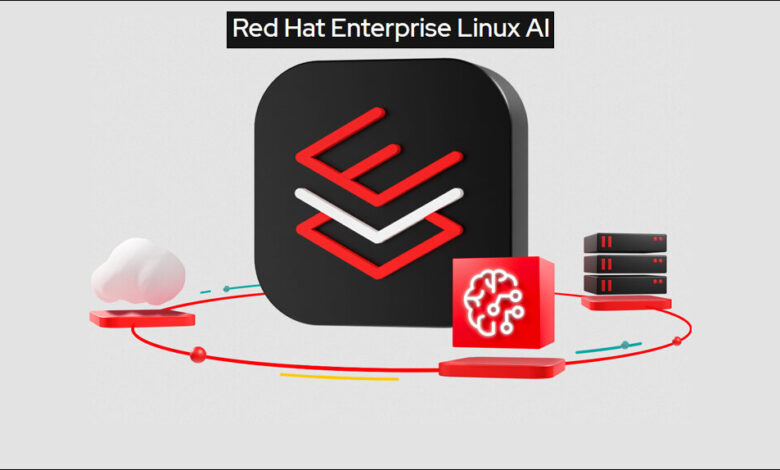Deciphering RHEL AI: An Open Source Approach to Artificial Intelligence

RHEL AI is an open-source platform aimed at making AI development accessible to everyone.
Have you ever lost yourself in an endless stream of reviews to find out which new restaurant to give a go? Isn’t it nice to have a personal assistant that reads through the comments and come up with the most suitable place depending on your specification? Well, what if the AI could assist you with that? Unfortunately, many AI models are enclosed for commercial use, which restricts their availability, openness, and shared within small organisations and independent developers. This is where RHEL AI comes in, as it is configured to optimally operate in hybrid and cloud environments.
RHEL AI is an open-source platform aimed at making AI development accessible to everyone. Based on the open-source principles, reliable architecture, and active involvement of the community of users and developers, RHEL AI can become the platform that will make AI more open, compatible, and reliable. Therefore, individuals do not have to rely solely on tech companies’ expertise to implement AI in building better tools, from restaurant guide apps to a spam-free world. This is what Red Hat AI is building for the future.
What is RHEL AI?
Red Hat Enterprise Linux (RHEL) AI is a versatile collection of tools and frameworks developed based on the solid RHEL base to support AI and machine learning application development, deployment, and administration. RHEL AI takes full advantage of open-source, providing a secure infrastructure and flexibility for AI users. Unveiled at the Red Hat Summit 2023 along with Red Hat OpenShift AI, it is designed to bring AI into the mainstream with open source approaches to AI models. To further enable AI development, Red Hat and IBM Research have been developing models for AI language and code assistance that would be open-sourced. This is a step towards a new approach making AI more accessible and practical for common use.
An integral part of this undertaking is InstructLab; it is an open-source venture that allows people to improve their artificial intelligence models by using an interface. Compared to other techniques that may require forking a model, InstructLab provides contributions that can be included in further versions. It makes AI development more democratic so that domain specialists and enthusiasts can create AI applications without requiring deep knowledge of data science. “Using InstructLab, Jim Whitehurst, the former CEO of Red Hat, believes that “everyone can build AI models regardless of their professional background”.
Key elements of the RHEL AI are:
- Scalability: Consider the performance of RHEL AI being used in financial institutions’s scalable ways. For instance, their first fraud detection system, which can run on a single server, can be easily integrated to run on multiple servers in a global data center. This allows them to be prepared to handle ever-increasing amounts of data and behavioral changes in the future.
- Security: Securing patient information is a top priority for the healthcare provider. RHEL AI’s adaptive security compliance capabilities can be used when using an AI-based diagnostic tool. This helps keep the data confidential during processing.
- Flexibility: An e-commerce company can dive flexibly by utilising RHEL AI, as it supports both TensorFlow and PyTorch. This enables the development and implementation of recommendation strategies that facilitate the delivery of a better customer experience.
- Integration: RHEL AI is built to complement products such as OpenShift and Ansible, providing Red Hat’s customers with an integrated solution for AI. For example, in a retail business where there is the use of containers, Ansible can be used to automatically deploy and control the same using OpenShift.
- Support and Services: Red Hat also provides substantial support and services to make sure that the users are equipped with all the resources they require for their AI projects.
Can really we open source AI?
Open source software has been one of the key drivers of innovation and has fostered shared development, code sharing, and decentralisation. Applying these principles to AI gives rise to certain possibilities and concerns. Open-source AI is not just about sharing code, but also permissions to use it, being able to use the training data, and, to some degree at least, being able to modify the models. For example, the Apache, MIT, and GPL licenses permit developers to use, modify, and distribute AI models to promote rapid innovation. Prominent examples include open-source projects like Hugging Face’s Transformers library, which provides access to model architectures and the training datasets, thus enabling auditing and trust in AI systems to be established. This transparency is important in reproducing results in scientific research and also important for understanding how these AI models will behave in different applications.
However, there are other famous AI models, like the OpenAI’s GPT-4, that have limitations imposed to the users that do not allow full visibility and openness. Open source projects such as TensorFlow show how participation from the public can lead to improvements in the functionality of AI. Therefore, complete open sourcing of AI is possible as well as advantageous, but it is essential to solve problems associated with data protection, ownership, and sustainability of interest in promoting open source to receive the most of it.
Impact of Open Source AI Principles
Open source AI models reduce the barriers of participation due to availability thereby creating a fertile ground for diverse developments. Users are able to understand and check training data of AI and its model weights to assure them of the process employed by AI. Furthermore, open source AI minimises the costs of development by not requiring costly licensed models and reaping from community contributions. The features like open access, collaboration, transparency, and relatively low cost create more reliable, flexible, and universal AI systems.
RHEL AI Models
- Granite Models: RHEL AI consists of IBM’s Granite LLM for both language- and code-generation purposes. These models are open source-licensed and backed by Red Hat, making them reliable for key business applications.
- InstructLab Model Alignment Tools: RHEL AI uses InstructLab’s alignment tools, which are developed following the LAB methodology of IBM Research. This methodology incorporates taxonomy-driven synthetic data generation as well as a multi-step tuning approach that increases the effectiveness and flexibility of the models.
- Optimised Runtime Instances: RHEL AI provides solutions with bootable instances that can fully function to work with important hardware accelerators from AMD, Intel, and NVIDIA. These instances are bundled with RHEL images, which makes their installation easier, and they tend to support various hardware configurations.
- Enterprise-Grade Support: Red Hat offers support for RHEL AI across production support as well as the product’s life cycle. This guarantees stability and reliability, making it even more suitable for use by enterprises around the world.
So what is Red Hat’s approach to AI?
Firstly, Red Hat aimed at AI workloads‘ foundation in infrastructure using Red Hat OpenShift AI. This platform makes it possible to achieve performance and reliability in the execution of AI models, supporting reliable AI operations in various businesses and industries. However, as already highlighted, Red Hat’s vision goes a step further than simply offering infrastructure. They want to create and offer AI models on their own, using the collective potential of open-source teams. This way the global developer community resources are incorporated into Red Hat’s offerings, thereby improving upon the performance and practicality of the AI models under development for ongoing complex situations and technologies.
Red Hat’s Long term vision
Both in Red Hat’s current and aspirational future of open-source, its emphasis on interoperability across hybrid-cloud architectures can allow its deployment in settings ranging from on-premises to the edge. Continuous interactions with the open source community make the models and tools for AI more enhanced as everyone is involved. Blending three decades of open-source innovation experience with its Linux and Kubernetes innovations, Red Hat brings AI availability to the masses with RHEL AI. This change guarantees the wide availability and integration of AI to empower organisations, regardless of their size. The CEO of Red Hat, Paul Cormier, opines that, “With RHEL AI and InstructLab, we are now opening up AI to open source where everyone can participate and gain from the advancement.”
Overall opinion
RHEL AI remains a source of hope in a world where open-source solutions are overshadowed by proprietary solutions. Through this approach, it removes the obstacles to the broad implementation of AI that have always been associated with high costs and limited access to proper resources. This helps promote the growth of diversity in the developer community and allows all parties to gain advantages.
The impact is far-reaching. Think of a place where clinicians could use open-source AI for diagnosis while having a full understanding of how the algorithm works, or imagine e-commerce firms having full authority over the customer experience, including recommendations. This is the future RHEL AI is adamant on creating-a future where everyone can have a taste of the power of AI. Although problems like data privacy and sustainability still exist, RHEL AI is quite a leap forward. It is praiseworthy and opens the avenues for open source creation to make advancements in conjunction with AI in the future.


